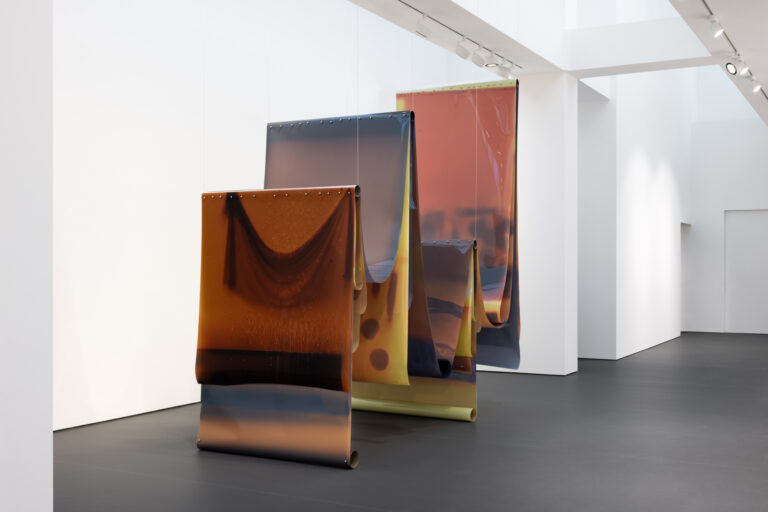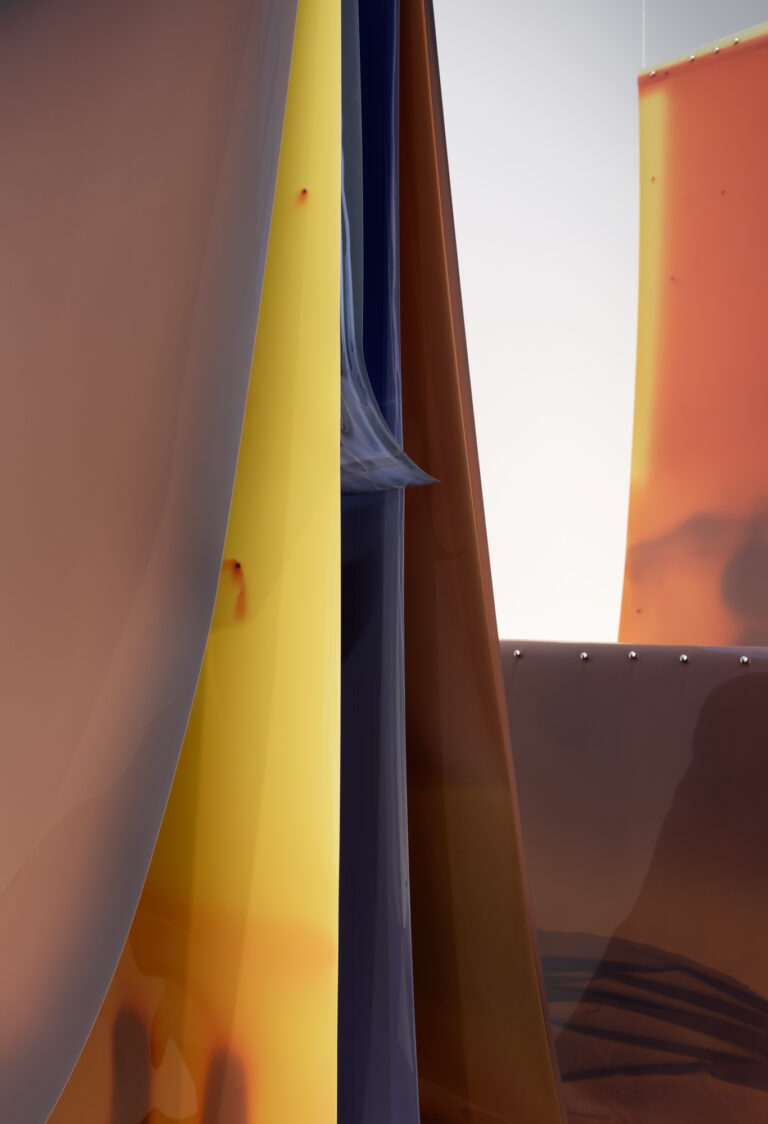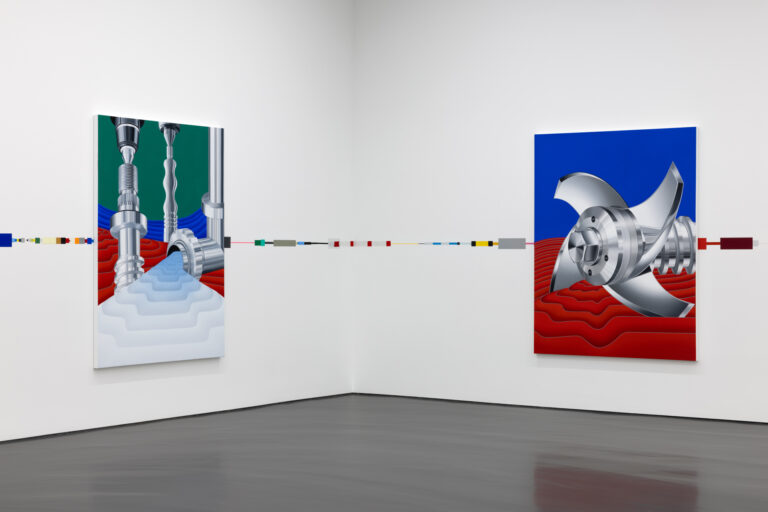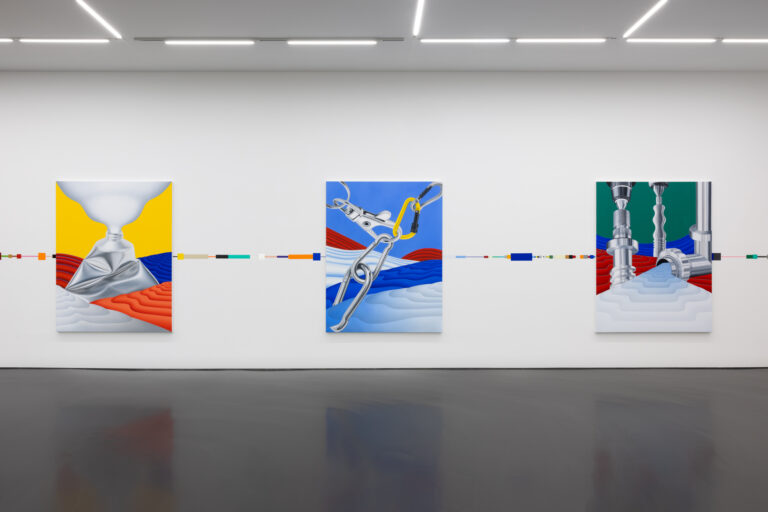Lotus L. Kang
Borne
14 NOV until 18 DEC 2025
Esther Schipper is pleased to present Borne, Lotus L. Kang’s first solo presentation with the gallery. On view will be a large-scale Molt work from her series of photographic sculptures, and a floor-bound sculpture from the series Receiver Transmitter.

Exhibition view:
Lotus L. Kang, Borne,
Esther Schipper, Berlin, 2025
Courtesy the artist and Esther Schipper, Berlin/Paris/Seoul
Photo © Andrea Rossetti
Conceived especially for this presentation, the works expands across the exhibition space, inviting visitors into intimate proximity. Lengths of unfixed industrial film— “skins” as Kang refers to them—are draped over and across raw steel tubes suspended from the ceiling. The shadowy impressions on the film create layered, visceral timescales, rendered in a palette of yellow, orange, red, purple and brown. By intentionally misusing the material, exposing it to sunlight and manipulating its exposure in both planned and unforeseen ways, the artist has invented modes of inscribing her process, turning the film into indexes of overlapping durations. The film is “tanned” ––or exposed––across multiple sites: her studio, her home, and predominantly, in a greenhouse situated in upstate New York. A structure that is not fully inside nor fully outside, the greenhouse embodies an in-between space that holds cycles of growth and decay.
Wooden pallets, mesh fabric, cardboard cut-outs, cast aluminum objects, splashes of rainwater, and the films’ own folding and touching leave the sheets with cryptic, shadowy traces, their glossy surfaces marked by experimentation and time. The reflective quality of the film mirrors the viewer and environment, offering a distorted echo of its surroundings and implicating the viewer. The raw film alludes to early photography’s purpose of documentation. However, Kang subverts such associations by deconstructing the medium, emphasizing the alchemical, embodied, and sculptural. For Kang, the unfixed and continually sensitive film resembles various membranes: cellular, plastic, textile, or synthetic. As her term “skins” suggests, the film is akin to the body’s largest organ. Worn on the outside rather than inside, it is strong and resistant yet vulnerable and absorptive. Skin is an active vessel: a connective, porous membrane where time is recorded and evidenced both legibly and illegibly. With their associations to bruise, blood or bile, the colors of the cascading film invoke the body’s fragility, resilience and leakiness.

Lotus L. Kang
Molt (Woodridge-New York-Berlin-), 2024 –
2025
Tanned and unfixed film (continually sensitive),
spherical magnets, cast aluminum kelp knots,
photograph, tape, steel wire and steel tubes
304,8 x 309,9 x 127 cm
Exhibition view: Lotus L. Kang, Borne,
Esther Schipper, Berlin, 2025
Courtesy the artist and Esther Schipper, Berlin/Paris/Seoul
Photo © Andrea Rossetti

Lotus L. Kang
Molt (Woodridge-New York-Berlin-), 2024 –
2025
Tanned and unfixed film (continually sensitive),
spherical magnets, cast aluminum kelp knots,
photograph, tape, steel wire and steel tubes
304,8 x 309,9 x 127 cm
Exhibition view: Lotus L. Kang, Borne,
Esther Schipper, Berlin, 2025
Courtesy the artist and Esther Schipper, Berlin/Paris/Seoul
Photo © Andrea Rossetti
Nearby, two tatami mats are folded and stacked, wrapped in industrial rubber, obscuring immediate recognition. Objects such as cast aluminum perilla leaves, yellow cellophane, bottles of spirits and photographs hidden in the tatami’s folds are arranged in and around the mats. Continuing the artist’s interest in the body without representation, the horizontal mats allude to a modular, migrating body in states of rest, dreaming or death, while speaking to layered histories of multiple origins. A chorus of plaster and metal cast baby birds, crying open mouthed and awaiting nourishment sit atop the sculpture. The birds, exposed and new, are both full of life and yet precarious in their vulnerable state. They show a volatile in-between stage of development, and symbolize inheritance, regurgitation and transformation. They embody a relentless longing for the “mother” body in all its expansive forms.

Lotus L. Kang
Receiver Transmitter (Borne), 2025
Tatami mats, gum rubber, organza, cast aluminum perilla leaves, 35mm film, photographs from the series Fleshing out the Ghost, photograph mounted on Dibond, cellophane, cast plaster, cast aluminum, cast bronze, cast silicone, paint, pig mented silicone, metallic twist tie, polypropylene, and spirits
50 x 105 x 61 cm
Exhibition view: Lotus L. Kang, Borne,
Esther Schipper, Berlin, 2025
Courtesy the artist and Esther Schipper, Berlin/Paris/Seoul
Photo © Andrea Rossetti

Lotus L. Kang
Receiver Transmitter (Borne), 2025
Tatami mats, gum rubber, organza, cast aluminum perilla leaves, 35mm film, photographs from the series Fleshing out the Ghost, photograph mounted on Dibond, cellophane, cast plaster, cast aluminum, cast bronze, cast silicone, paint, pig mented silicone, metallic twist tie, polypropylene, and spirits
50 x 105 x 61 cm
Exhibition view: Lotus L. Kang, Borne,
Esther Schipper, Berlin, 2025
Courtesy the artist and Esther Schipper, Berlin/Paris/Seoul
Photo © Andrea Rossetti
The exhibition’s title is twofold, implying both birth or a new beginning – each finely tied to death and renewal – and to carry, endure or support. With her work, Kang draws attention to the continuity of the body beyond its physical containment, suggesting that we are carriers of multiple durations, in perpetual cycles of life and death.
The artist gratefully acknowledges Denniston Hill for their ongoing support in facilitating space for her greenhouse, located within the ancestral territory of the Esopus people of Lenapehoking, otherwise known as Woodridge in the Southern Catskill Mountains.

Exhibition view:
Lotus L. Kang, Borne,
Esther Schipper, Berlin, 2025
Courtesy the artist and Esther Schipper, Berlin/Paris/Seoul
Photo © Andrea Rossetti
Lotus L. Kang was born 1985 in Toronto. Kang studied fine arts at Concordia University in Montreal (20042008) and completed an MFA at the Milton Avery School of the Arts at Bard College, New York, in 2015. The artist lives and works in New York.
Selected residencies include the Rivers Institute for Contemporary Art and Thought, New Orleans (2024), Triangle Arts Association, New York (2022 and 2023), Horizon Art Foundation, Los Angeles (2022) and Rupert Residency, Vilnius, Lithuania (2018).
Selected solo exhibitions: Already, 52 Walker, New York (2025); In Cascades, CAG Vancouver, Vancouver (2023), and Chisenhale Gallery, London (2023), and Molt, MCA Chicago, Chicago (2023).
Selected institutional group exhibitions: What is Parasite and What is Kin?, Museum of Modern Art – MoMA, New York (2025); Key Operators, Kunstverein München, Munich (2024); After Images, Julia Stoschek Foundation, Berlin (2024); A Woman You Thought You Knew, Kadist, San Francisco (2024); Whitney Biennial 2024: Even Better Than the Real Thing, Whitney Museum of American Art, New York (2024); GTA Triennial 2024, Museum of Contemporary Art, Toronto (2024); We Are Story, Art Gallery of Ontario, Toronto (2023); New Museum Triennial: Soft Water Hard Stone, New Museum, New York (2021); In Practice: Total Disbelief, Sculpture Center, New York (2020); If I have a body, Remai Modern, Saskatoon, Canada (2019).
Her work is held in the following collections: Museum of Modern Art, New York; Art Gallery of Ontario, Toronto; Fondazione Rivoli Due, Milan; Wrocław Contemporary Museum, Wrocław; Museum of Contemporary Art, Los Angeles; Kadist, San Francisco; Whitney Museum of American Art, New York; The Morgan Library & Museum, New York; CC Foundation, Shanghai; RBC Corporate Art Collection, Toronto; TD Bank Art Collection, Toronto; Scotiabank Art Collection, Toronto; and The Musée d’art contemporain de Montréal, Montreal.
Jac Leirner & Rafa Silvares
Ensemble
14 NOV until 18 DEC 2025
Esther Schipper is pleased to announce Ensemble, bringing together works by Jac Leirner and Rafa Silvares. The exhibition marks Silvares’s first and Leirner’s third with the gallery. The year Silvares was born some hundred kilometers inland, Leirner completed her artistic education; decades later, Silvares would study at the same institute in São Paulo. Continuing their rich correspondence, the exhibition is a result of the artists’s exchange within each other’s universes. Taking the habit to pick up, sketch, and keep quotidian items as a point of departure, the artists’s dialogue echoes an ode to collecting.

Exhibition view: Jac Leirner and Rafa Silvares,
Ensemble, Esther Schipper, Berlin, 2025
Courtesy the artist and Esther Schipper, Berlin/Paris/Seoul
Photo © Andrea Rossetti
A new iteration of Leirner’s groundbreaking work, Hip Hop (1998/2025), extends along the exhibition space’s walls. Held in the Solomon R. Guggenheim collection, Hip Hop has been presented in eight institutions across continents. For this presentation, Leirner has produced a new version of the historic piece, adding a motif, “scratch,” a sequence of four parallel, diagonal bars. The installation, while paying homage to Piet Mondrian’s penultimate painting Broadway Boogie Woogie (1942–43), takes its name from the unruly beats that jumped from New York’s Bronx onto the world stage. In its materiality, the work, comprised of a horizontal line made from hundreds of pieces of adhesive tape in different widths, colors and thickness, testifies to the music genre’s sticky sociality: once emerging from Black and Brown block parties, today, hip hop continues to laud the intersection of drums, voice, and dance. By combining chromatic confrontation and square elongation, Leirner translates the phonetic of the name “hip hop” into space. Bouncy and saturated, the work resonates with the music genre’s pulsating loops and highlights the importance of Leirner’s musical background as a formative experience. Borne by the transgressive potential of music, Hip Hop recalls an adaptation of roaring frequencies into the optics of rhythm. Spun around its own axis, Anthropomorphic (2024), consisting of a metal chain through which blue plastic bags have been threaded, reiterates the motive force of rhythm within a sculptural grammar.
Six new paintings by Silvares are installed across Hip Hop, which runs through their core and resumes a connective horizontal line between them. Four large-scale paintings are hung sequentially; each depicts an abstract landscape comprised of viscous mounds that appear to unfurl slowly, interrupted only by the crisp contour of metallic objects. Metal is a recurring motif that exerts symbolic power; its hard, lustrous, reflective shell evokes the promise of modernity with its scientistic notions of cleanliness and the antiseptic. In Pillars (2025), a finely polished pipe empties a bulge of viscid silver into the painting’s foreground while Mill (2025) exhibits a helical screw blade. Titanium (2025) depicts a clenched tube facing it’s squeezed-out white paint; the silhouette is reminiscent of an hourglass and idiosyncratic for the artist’s seamless brush strokes. Hyperlink (2025) depicts interlocked snap hooks and pays tribute to Leirner’s trademark gesture of tying, clipping, or otherwise attaching products bought at hardware stores into extensive installations. Time appears arrested in Pole (2025); suggestive of a melting pillar, the work’s vertical composition briefly halts Hip Hop, while tapping into Anthropomorphic’s tall, tranquil dynamic. Executed in oil, Silvares’s 808 (2025), depicts shiny and perfectly round knobs in aluminum grey, embraced by intense shades of red, yellow, and blue that read as another nod to Mondrian. Another reference, indicated by the work’s title, is the iconic drum machine Roland TR-808 Rhythm Composer, a bedrock of early hip hop samples.

Exhibition view: Jac Leirner and Rafa Silvares,
Ensemble, Esther Schipper, Berlin, 2025
Courtesy the artist and Esther Schipper, Berlin/Paris/Seoul
Photo © Andrea Rossetti

Exhibition view: Jac Leirner and Rafa Silvares,
Ensemble, Esther Schipper, Berlin, 2025
Courtesy the artist and Esther Schipper, Berlin/Paris/Seoul
Photo © Andrea Rossetti
As though sampled beats looped on Silvares’s 808, taking the shape of Leirner’s Hip Hop, were bouncing back from the gallery walls, the exhibition stages the transposition of sound into color by uncovering their substantial form: frequency. Side by side, and one above the other, Leirner and Silvares extend their exploration of chromatic vibration into an ensemble of rhythmic interventions. Both artists draw on an untamed color palette, not shying away from vibrant hues, loud accentuation, or pointed contrasts. Yet, the deliberate placement of color in their respective work exhibits an aesthetic of sensorial fine-tuning. What drives the artists’s parsing of color through spatio-temporal unfolding, then, is not the chilled metrics of containment, but rather an enduring attraction to intensity, rhythm, and frequency.

Exhibition view: Jac Leirner and Rafa Silvares,
Ensemble, Esther Schipper, Berlin, 2025
Courtesy the artist and Esther Schipper, Berlin/Paris/Seoul
Photo © Andrea Rossetti
Jac Leirner was born in 1961 in São Paulo, where she lives and works. In 1984, she received her BFA in Fine Arts from the Fundação Armando Álvares Penteado, in São Paulo.
The artist was awarded numerous grants and residencies, among them: 2019 Wolfgang Hahn Prize; 2012 APCA Award: Best Exhibition of the Year – Estação Pinacoteca, Sao Paulo; 2012 artist in residence at the Yale University School of Art; 2001 John Simon Guggenheim Fellowship; 1998 visiting artist at the Rijksakademie van Beeldende Kunsten, Amsterdam; 1991 visiting artist at the University College, Oxford; 1991 visiting artist at the Ruskin School of Drawing and Fine Arts, University of Oxford; 1991 artist in residency at the Museum of Modern Art in Oxford, and the 1991 artist in residency at the Walker Art Center, Minneapolis.

Exhibition view: Jac Leirner and Rafa Silvares,
Ensemble, Esther Schipper, Berlin, 2025
Courtesy the artist and Esther Schipper, Berlin/Paris/Seoul
Photo © Andrea Rossetti
Selected solo exhibitions include: Jac Leirner, Swiss Institute, New York (2023); Us Horizon, Esther Schipper, Berlin (2022); Jac Leirner. Wolfgang Hahn Prize 2019, Museum Ludwig, Cologne (2019); Institutional Ghost, IMMA Dublin (2017); Borders are Drawn by Hand, MoCa Pavilion, Shanghai (2016); Jac Leirner. Functions of a variable, Museo Tamayo, Mexico City (2014); Jac Leirner, Pinacoteca do Estado de São Paulo, Sao Paulo (2011); Adhesive 44, Miami Art Museum, Miami (2004); Projeto Parede, Museu de Arte Moderna de São Paulo, Sao Paulo (1999); Directions, Hirshhorn Museum and Sculpture Garden, Washington D.C. (1992); Currents, ICA, Boston, (1991), and Viewpoints, Walker Art Center, Minneapolis (1991).
Rafa Silvares was born in 1984 in Santos, Brazil. He studied fine arts at FAAP (Fundação Armando Alvares Penteado), São Paulo and received a BA in Language and Literature from the Faculty of Philosophy, Languages, and Human Sciences (FFLCH) at the University of São Paulo.
The artist was a Pipa Award Nominee in 2020. Among his residencies were in 2021 The Fores Project, London (2021); La Centrale residence, Paris (2018); and Pivô research, Pivô São Paulo (2016). In 2008 the artist participated in the 28th São Paulo Biennial, in collaboration with AVAF.
Recent exhibitions include: Ganz konkret 2, Kunstpalais, Erlangen (2025); L’Almanach 23, Le Consortium, Dijon (2023); Real Fake Door, Arsenal Contemporary Art, New York (2023); The Artists Contemporary Atelier, London (2021); Monster High, Olhão, São Paulo (2020); 48th Luiz Sacilotto Art Salon, Casa do olhar, Santo André (2020); Bife, Olhão, Sao Paulo (2019); Traço, Platô Studio, São Paulo (2016); Pivô Art Research, Pivô, São Paulo (2016); I Scream, critical follow up of Galciani Neves and Regina Parra, Galpão Glicério, São Paulo (2015); 21th Praia Grande Art Salon, Praia Grande (2014); Dizzy World, Paper Box, New York, NY (2013); and Parahaus, São Paulo (2011).
